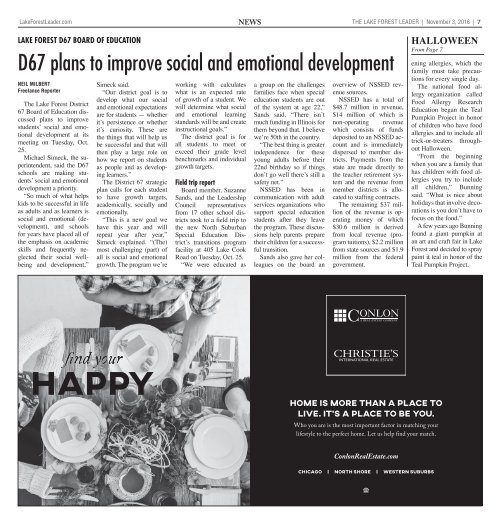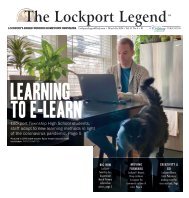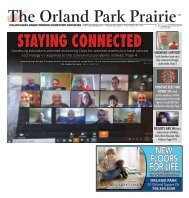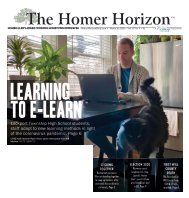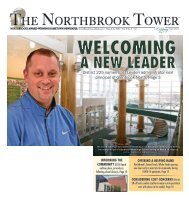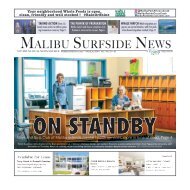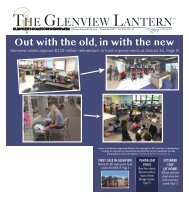LF_110316
The Lake Forest Leader 110316
The Lake Forest Leader 110316
You also want an ePaper? Increase the reach of your titles
YUMPU automatically turns print PDFs into web optimized ePapers that Google loves.
LakeForestLeader.com news<br />
the lake forest leader | November 3, 2016 | 7<br />
Lake Forest D67 Board of Education<br />
D67 plans to improve social and emotional development<br />
Neil Milbert<br />
Freelance Reporter<br />
The Lake Forest District<br />
67 Board of Education discussed<br />
plans to improve<br />
students’ social and emotional<br />
development at its<br />
meeting on Tuesday, Oct.<br />
25.<br />
Michael Simeck, the superintendent,<br />
said the D67<br />
schools are making students’<br />
social and emotional<br />
development a priority.<br />
“So much of what helps<br />
kids to be successful in life<br />
as adults and as learners is<br />
social and emotional (development),<br />
and schools<br />
for years have placed all of<br />
the emphasis on academic<br />
skills and frequently neglected<br />
their social wellbeing<br />
and development,”<br />
Simeck said.<br />
“Our district goal is to<br />
develop what our social<br />
and emotional expectations<br />
are for students — whether<br />
it’s persistence or whether<br />
it’s curiosity. These are<br />
the things that will help us<br />
be successful and that will<br />
then play a large role on<br />
how we report on students<br />
as people and as developing<br />
learners.”<br />
The District 67 strategic<br />
plan calls for each student<br />
to have growth targets,<br />
academically, socially and<br />
emotionally.<br />
“This is a new goal we<br />
have this year and will<br />
repeat year after year,”<br />
Simeck explained. “(The)<br />
most challenging (part) of<br />
all is social and emotional<br />
growth. The program we’re<br />
working with calculates<br />
what is an expected rate<br />
of growth of a student. We<br />
will determine what social<br />
and emotional learning<br />
standards will be and create<br />
instructional goals.”<br />
The district goal is for<br />
all students to meet or<br />
exceed their grade level<br />
benchmarks and individual<br />
growth targets.<br />
Field trip report<br />
Board member, Suzanne<br />
Sands, and the Leadership<br />
Council representatives<br />
from 17 other school districts<br />
took to a field trip to<br />
the new North Suburban<br />
Special Education District’s<br />
transitions program<br />
facility at 405 Lake Cook<br />
Road on Tuesday, Oct. 25.<br />
“We were educated as<br />
a group on the challenges<br />
families face when special<br />
education students are out<br />
of the system at age 22,”<br />
Sands said. “There isn’t<br />
much funding in Illinois for<br />
them beyond that. I believe<br />
we’re 50th in the country.<br />
“The best thing is greater<br />
independence for these<br />
young adults before their<br />
22nd birthday so if things<br />
don’t go well there’s still a<br />
safety net.”<br />
NSSED has been in<br />
communication with adult<br />
services organizations who<br />
support special education<br />
students after they leave<br />
the program. These discussions<br />
help parents prepare<br />
their children for a successful<br />
transition.<br />
Sands also gave her colleagues<br />
on the board an<br />
overview of NSSED revenue<br />
sources.<br />
NSSED has a total of<br />
$48.7 million in revenue,<br />
$14 million of which is<br />
non-operating revenue<br />
which consists of funds<br />
deposited to an NSSED account<br />
and is immediately<br />
dispersed to member districts.<br />
Payments from the<br />
state are made directly to<br />
the teacher retirement system<br />
and the revenue from<br />
member districts is allocated<br />
to staffing contracts.<br />
The remaining $37 million<br />
of the revenue is operating<br />
money of which<br />
$30.6 million is derived<br />
from local revenue (program<br />
tuitions), $2.2 million<br />
from state sources and $1.9<br />
million from the federal<br />
government.<br />
Halloween<br />
From Page 7<br />
ening allergies, which the<br />
family must take precautions<br />
for every single day.<br />
The national food allergy<br />
organization called<br />
Food Allergy Research<br />
Education began the Teal<br />
Pumpkin Project in honor<br />
of children who have food<br />
allergies and to include all<br />
trick-or-treaters throughout<br />
Halloween.<br />
“From the beginning<br />
when you are a family that<br />
has children with food allergies<br />
you try to include<br />
all children,” Bunning<br />
said. “What is nice about<br />
holidays that involve decorations<br />
is you don’t have to<br />
focus on the food.”<br />
A few years ago Bunning<br />
found a giant pumpkin at<br />
an art and craft fair in Lake<br />
Forest and decided to spray<br />
paint it teal in honor of the<br />
Teal Pumpkin Project.


